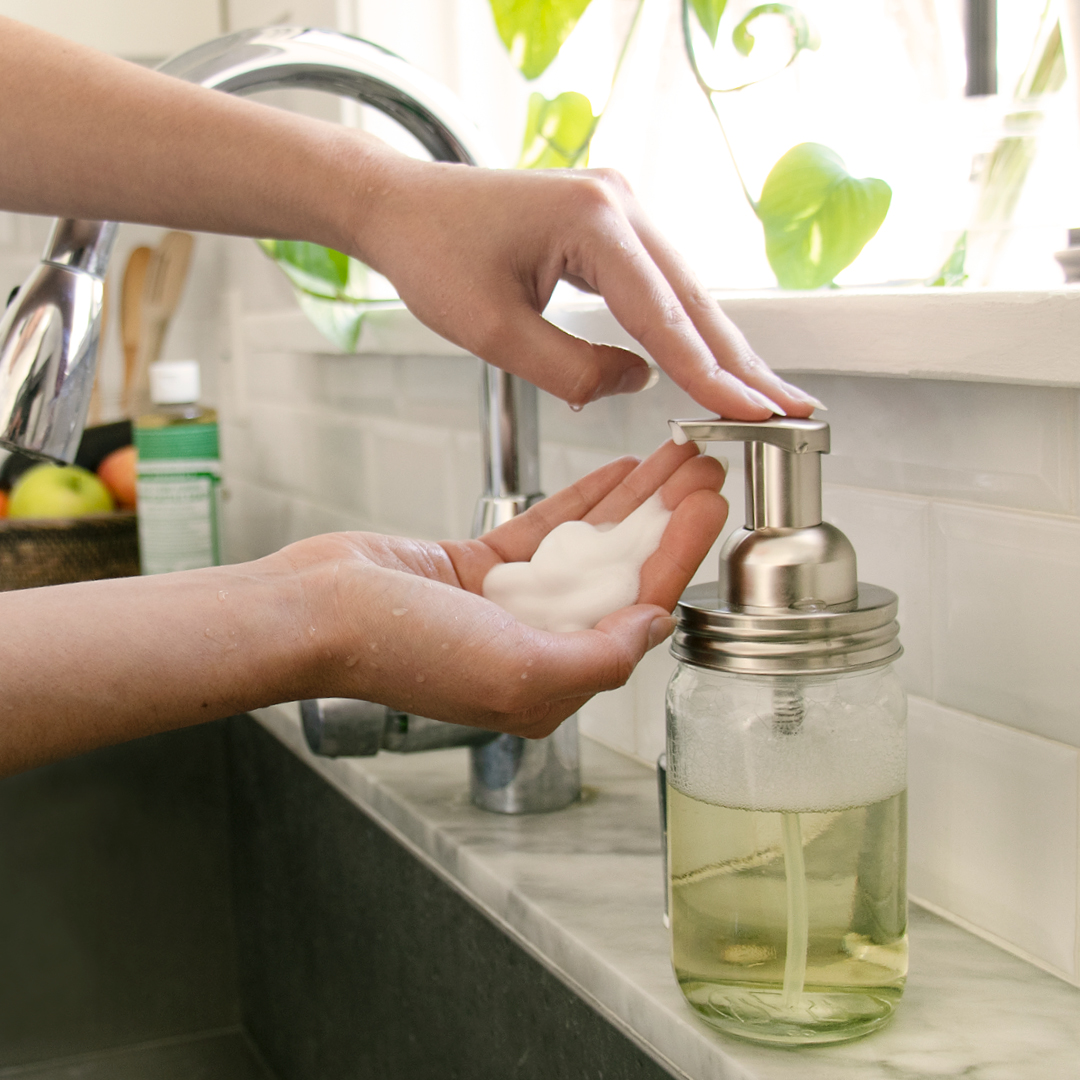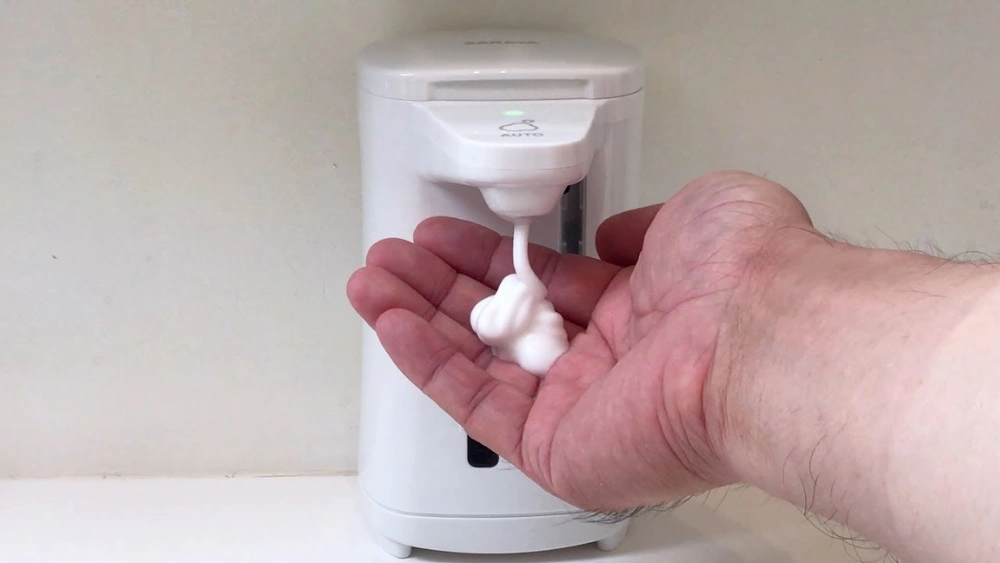Have you ever wondered what makes your foaming soap dispenser so special? It’s not just a regular soap bottle—it turns liquid soap into a rich, fluffy foam that feels soft on your hands.
But how does this magic happen? Understanding how a foaming soap dispenser works can help you appreciate its clever design and maybe even choose the right one for your home. Keep reading, and you’ll discover the simple science behind this everyday gadget and why it’s more effective than you might think.
Your hands—and your soap—will thank you!
Foaming Soap Basics
Understanding the basics of foaming soap helps you appreciate why so many people prefer it over traditional liquid soap. It’s not just about the fun bubbles; the way foaming soap works affects how you use it, how much soap you waste, and even how clean your hands feel after washing. Let’s break down what foaming soap really is and how it differs from regular liquid soap.
What Is Foaming Soap
Foaming soap is a special type of soap designed to come out of the dispenser already full of bubbles. Unlike regular soap that’s thick and liquid, foaming soap has a lighter texture. This happens because the soap is mixed with air inside the dispenser before it reaches your hands.
Think about the last time you used a foaming soap dispenser. The soap felt airy and spread easily over your skin. That’s because the dispenser uses a small pump and a mesh screen to mix soap with air, creating the foam instantly.
Differences From Liquid Soap
Liquid soap is thicker and comes out as a gel or liquid. You need to rub it more to create lather, which means using more water and time. Foaming soap, on the other hand, already has the bubbles made, so it spreads quickly and rinses off faster.
- Usage:Foaming soap uses less soap per wash because the foam spreads easily.
- Economy:You can save money as foaming dispensers mix soap with air, reducing the amount of soap used.
- Experience:Many people find foaming soap feels cleaner and less sticky after rinsing.
Have you noticed how your hands feel after washing with foaming soap compared to liquid soap? That difference in texture can change your whole handwashing routine.

Credit: www.lisabronner.com
Dispenser Components
Understanding the key components inside a foaming soap dispenser helps you see why it feels so satisfying to use. Each part plays a vital role in turning liquid soap into that rich, fluffy foam you enjoy. Let’s break down these components to see how they work together smoothly every time you press the dispenser.
Pump Mechanism
The pump mechanism is the heart of the dispenser. When you press it, it pushes soap and air through a tiny mesh screen. This action creates the foam by mixing soap with air in just the right amount.
Have you ever noticed how some dispensers feel harder to press? That often means the pump needs cleaning or the spring inside is worn out. Keeping the pump in good shape ensures consistent foam with every use.
Air Intake System
The air intake system allows air to enter the dispenser and mix with the soap. Without this system, the soap would come out as a liquid, not foam. It usually involves small vents or tubes that pull air in during the pumping action.
Think about how a bubble wand works by mixing air and soap to make bubbles. The air intake system does a similar job, but much faster and in a controlled way. This is why you get that light, foamy texture instead of just soap squirting out.
Soap Reservoir
The soap reservoir is simply the container that holds the liquid soap. It’s designed to keep the soap sealed and ready for use. You can refill it easily, which is handy when your favorite soap runs out.
Choosing the right soap for your dispenser matters. Thicker soaps may clog the pump, while very thin soaps might not foam well. Have you ever experimented with different soaps to see how the foam changes? It can be quite revealing about how the reservoir and pump work together.
How Foam Is Created
Foam is created by mixing air and soap in a special way. This process changes liquid soap into light, fluffy foam. The design of the dispenser helps mix these two elements perfectly. The result is soap that feels soft and spreads easily on your hands.
Mixing Air And Soap
Inside the dispenser, air and soap combine in a small chamber. When you press the pump, it pushes both air and soap together. This mixture forms tiny bubbles. These bubbles group and create foam. The right amount of air is important for good foam quality.
Role Of Nozzle Design
The nozzle controls how air and soap blend. It has small openings that shape the flow. These openings help create fine bubbles. The nozzle also controls foam thickness and texture. A well-designed nozzle makes soft, rich foam every time.

Credit: kuishi.com
Types Of Foaming Dispensers
Foaming soap dispensers come in different types, each designed to deliver soap efficiently while meeting various needs. Understanding the differences can help you choose the right one for your home or office. Whether you want something simple or more high-tech, there’s a foaming dispenser that fits your style.
Manual Models
Manual foaming soap dispensers require you to press a pump to release the soap. When you push down, the pump mixes air with liquid soap inside a special chamber, creating foam. This design is straightforward, reliable, and doesn’t need batteries or electricity.
These models often have clear containers so you can see when soap is running low. You control how much soap you get by how hard and how many times you press the pump. Have you noticed how some manual dispensers produce richer foam than others? That’s usually due to the quality of the internal mixing mechanism.
Automatic Sensors
Automatic foaming soap dispensers use built-in sensors to detect your hand and release foam without any touch. This touchless system reduces the spread of germs, making it perfect for public spaces or kitchens. Sensors usually work through infrared technology that senses when your hand is close enough.
Most automatic models run on batteries and have adjustable settings to control the amount of foam dispensed. These dispensers add a modern feel and convenience to your routine, but they might require occasional battery changes. Do you find it easier to keep your hands clean with touchless dispensers? Many users do, especially in busy environments.
Advantages Of Foaming Soap
Foaming soap dispensers mix air with liquid soap, creating rich foam instantly. This foam spreads easily and rinses off quickly, saving soap and water. Using foam also feels gentle on hands and helps keep them cleaner.
Foaming soap dispensers offer several advantages that traditional dispensers cannot. They are not only convenient but also promote efficient use of soap. Foaming soap ensures better hand coverage, making hand washing more effective. These dispensers also align with eco-friendly practices, reducing the overall environmental impact. Let’s explore these advantages further.Efficient Soap Usage
Foaming soap dispensers use less soap per wash. The soap is mixed with air, creating a rich lather. This means you use less soap while still getting clean hands. Less soap usage saves money in the long run. It also reduces the need for frequent refills.Better Hand Coverage
Foaming soap spreads easily across the skin. The bubbly texture covers more surface area. This ensures all parts of your hands are cleaned effectively. It reaches between fingers and around nails, areas often missed with liquid soap.Eco-friendly Benefits
Foaming soap dispensers are kinder to the planet. They reduce plastic waste due to less packaging. Less soap usage means fewer chemicals in water systems. This makes foaming soap an environmentally conscious choice.Maintenance Tips
Proper care keeps your foaming soap dispenser working well. Regular maintenance prevents clogs and ensures smooth foaming action.
Simple steps help extend the dispenser’s life and improve hygiene.
Cleaning The Dispenser
Remove the pump from the bottle before cleaning. Rinse the pump with warm water to clear soap residue. Soak the pump in warm water for a few minutes if it clogs. Use a soft brush to clean hard-to-reach areas. Avoid harsh chemicals that may damage the dispenser. Wipe the exterior with a damp cloth to remove dirt and grime.
Refilling Properly
Use the correct soap mixture for foaming dispensers. Mix soap with water at the ratio recommended by the manufacturer. Avoid using thick or gel soaps as they can clog the pump. Pour the soap mixture slowly to prevent spills. Do not overfill the bottle; leave space for air to mix with soap. Secure the pump tightly after refilling to avoid leaks.

Credit: www.amazon.in
Frequently Asked Questions
How Does A Foaming Soap Dispenser Mix Soap And Air?
A foaming soap dispenser uses a special pump that blends liquid soap with air. This mixture creates foam when dispensed. The pump forces air into the soap, producing a rich, airy lather that cleans effectively while using less soap.
Why Is Foaming Soap Better Than Liquid Soap?
Foaming soap spreads more easily and rinses off faster than liquid soap. It uses less soap per wash, reducing waste. The airy texture feels gentle on skin and encourages thorough handwashing, making it a popular and eco-friendly choice.
Can Any Soap Be Used In A Foaming Dispenser?
No, only soap specially formulated for foaming dispensers should be used. Regular liquid soaps are too thick and can clog the pump. Foaming soaps have a thinner consistency that mixes well with air to create foam.
How Often Should You Refill A Foaming Soap Dispenser?
Refill your foaming soap dispenser when the foam flow decreases or stops. Frequency depends on usage but typically ranges from one to two weeks in busy areas. Regular refilling ensures consistent foam quality and hygienic handwashing.
Conclusion
Foaming soap dispensers mix air and soap to create foam. This process saves soap and cleans hands gently. The pump pushes soap through a mesh, adding air bubbles. Foam feels soft and spreads easily on skin. These dispensers help reduce waste and keep hands fresh.
Using one is simple and quick every day. Understanding how they work helps you choose the right soap dispenser. Clean hands made easy and efficient. A smart addition to any bathroom or kitchen.

